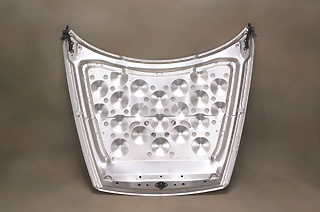Mazda Motor Corporation has developed a "Shock Cone Aluminum Hood,"
which has an all-new impact-absorbing structure aimed at enhancing pedestrian
protection. Compared to conventional framed aluminum hoods, this new structure
has the potential to significantly reduce the severity of head injuries
that can result when a pedestrian is struck by a car. The all-new hood
will be used on the Mazda RX-8 due to appear in showrooms this spring,
and will be gradually incorporated into other Mazda products.

Shock Cone Aluminum Hood (inner surface)
Framed hoods, which are conventionally used for vehicles, have an inner
panel with a bone structure to act as reinforcement. For pedestrian protection,
safety engineers traditionally control impact absorption by adjusting
the way the bone structure crumples. However, the framed inner panel inevitably
leaves some hard points that may not fully absorb the forces of an impact.
Instead of a framed structure, the "Shock Cone Aluminum Hood"
on the RX-8 has an inner panel that is uniquely shaped with numerous
craters, similar to cones. The structure with these craters, called
"shock cone," yields effective impact absorption across the
entire surface of the hood. This is the first time that this structure
has been applied to hoods with the aim of enhancing impact absorption
to improve pedestrian protection.
Major characteristics and advantages of the new 'Shock Cone Aluminum
Hood'
| 1) | Dramatically reduces the severity of head injuries sustained
by pedestrians in accident
The shock cone structure achieves consistent impact absorption capacity
across the entire hood surface. This reduces the extent of head
injuries sustained by pedestrians who hit the hood after being struck
by a car. In internal tests conducted under European NCAP pedestrian
head protection test conditions, the new hood was shown to reduce
the degree of head injury by as much as 50 percent when compared
to a conventional aluminum hood structure. |
| 2) |
Reduced gap between hood and engine
The gap between the hood and engine is designed by taking into account
the degree of intrusion into the engine compartment in a
collision. The relatively even intrusion level and effective impact-absorbing
properties of the new hood structure allowed engineers to reduce
the gap between the engine and hood by one-third (approximately
30mm). This configuration, along with the low center of gravity
and compact size of the rotary engine, made it possible to employ
a low hood design for the RX-8 that complements its athletic, sports
car styling. |
| 3) |
Enhanced rigidity and substantial weight reduction
Despite a twenty-two-percent reduction in the thickness of the inner
panel, the new hood structureis 1.5 times stronger in torsional
rigidity than hoods made using traditional construction. With a
weight per unit area of 4.87kg/m2, the new aluminum hood is 23 percent
lighter than that of the Mazda RX-7, and 9 percent lighter than
that of the Mazda Roadster. |
Whilst automakers have been working very hard to enhance vehicle safety
in the event of collisions through the introduction of new technologies,
improvements to pedestrian protection are urgently needed. According to
a report provided by the Institute for Traffic Accident Research and Data
Analysis, around 30% of deaths resulting from traffic accidents are pedestrians,
60% of whom died from fatal head injuries.
In addition to "Shock Cone Aluminum Hood," Mazda plans to
develop other technologies that demonstrate the company's commitment
to pedestrian safety.
|

